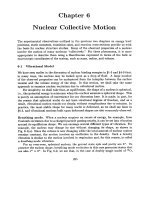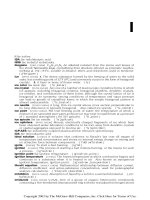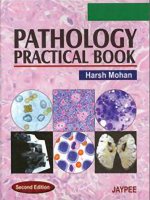Ebook Pharmacology for dentistry (2nd edition): Part 1
Bạn đang xem bản rút gọn của tài liệu. Xem và tải ngay bản đầy đủ của tài liệu tại đây (2.11 MB, 213 trang )
Pharmacology for Dentistry
This page intentionally left blank
Pharmacology
for Dentistry
Second Edition
Tara V Shanbhag MD
Professor, Department of Pharmacology
Srinivas Institute of Medical Sciences and
Research Centre, Mukka, Surathkal, Mangalore, Karnataka
Formerly, Professor, Department of Pharmacology
Kasturba Medical College, Manipal University
Manipal, Karnataka
Smita Shenoy MD
Additional Professor, Department of Pharmacology
Kasturba Medical College, Manipal University
Manipal, Karnataka
Veena Nayak MD
Associate Professor, Department of Pharmacology
Kasturba Medical College, Manipal University
Manipal, Karnataka
ELSEVIER
A division of
Reed Elsevier India Private Limited
Pharmacology for Dentistry, 2/e
Shanbhag, Shenoy and Nayak
© 2014 Reed Elsevier India Private Limited. All rights reserved.
No part of this publication may be reproduced or transmitted in any form or by any means, electronic or
mechanical, including photocopying, recording, or any information storage and retrieval system, without
permission in writing from the Publisher.
This book and the individual contributions contained in it are protected under copyright by the Publisher
(other than as may be noted herein).
ISBN: 978-81-312-3455-6
Notices
Knowledge and best practice in this field are constantly changing. As new research and experience broaden our
understanding, changes in research methods, professional practices, or medical treatment may become necessary.
Practitioners and researchers must always rely on their own experience and knowledge in evaluating and using
any information, methods, compounds, or experiments described herein. In using such information or methods
they should be mindful of their own safety and the safety of others, including parties for whom they have a
professional responsibility.
With respect to any drug or pharmaceutical products identified, readers are advised to check the most current
information provided (i) on procedures featured or (ii) by the manufacturer of each product to be administered,
to verify the recommended dose or formula, the method and duration of administration, and contraindications.
It is the responsibility of practitioners, relying on their own experience and knowledge of their patients, to make
diagnoses, to determine dosages and the best treatment for each individual patient, and to take all appropriate
safety precautions.
To the fullest extent of the law, neither the Publisher nor the authors, contributors, or editors, assume any liability
for any injury and/or damage to persons or property as a matter of products liability, negligence or otherwise,
or from any use or operation of any methods, products, instructions, or ideas contained in the material herein.
Please consult full prescribing information before issuing prescription for any product mentioned in this
publication.
The Publisher
Published by Elsevier, a division of Reed Elsevier India Private Limited
Registered Office: 305, Rohit House, 3 Tolstoy Marg, New Delhi-110 001
Corporate Office: 14th Floor, Building No. 10B, DLF Cyber City, Phase II, Gurgaon-122 002, Haryana, India
Senior Content Strategist: Nimisha Goswami
Senior Project Manager-Education Solutions: Shabina Nasim
Project Coordinator: Shravan Kumar
Copy Editor: Richa Srivastava
Manager-Publishing Operations: Sunil Kumar
Production Manager: NC Pant
Cover Designer: Raman Kumar
Typeset by Chitra Computers, New Delhi
Printed and bound at
Foreword to the First Edition
Pharmacology has undergone phenomenal growth in terms of information on mechanism of action and
clinical application of drugs. The main objective of teaching pharmacology is to provide a rationale for
choosing and prescribing drugs skillfully to relieve patient’s sufferings. Dental practitioners use drugs
not only for dental problems but also for management of medical emergency during dental treatment.
It is not enough for dentists to have knowledge on the use of these drugs, they should also have a sound
knowledge of pharmacology of other drugs in order to prevent the chances of drug interactions, which
the patient may be taking for co-morbid conditions.
Pharmacology for Dental Students covers drugs acting on all systems in a methodical way. The book
starts with the general pharmacological principles with which all prescribers must be conversant. This
is followed by systemic pharmacology, i.e. drugs acting on various systems. The authors have organized
each chapter systematically beginning with definitions, classification of drugs, description on various
groups of drugs followed by management or treatment of various conditions and finally a few model
questions.
A separate chapter on Dental Pharmacology covers various preparations that dentists use in their
day-to-day practice. Enough coverage is given to manage medical emergencies during dental practice
such as anaphylactic shock, bronchial asthma, angina pectoris, seizures, etc. Lastly, the appendix covers
a list of commonly prescribed drugs with dose and route of administration.
My best wishes to the authors.
Dr K L Bairy
Professor and Head
Department of Pharmacology
Kasturba Medical College
Manipal University
Manipal, Karnataka, India
This page intentionally left blank
Preface to the Second Edition
The main objective of the Second Edition of Pharmacology for Dental Students (now, more aptly named
as Pharmacology for Dentistry) is significant expansion and revision of the existing first edition.
In this book, importance is given to dental implications of many drugs and proper guidelines to
tackle the emergency conditions that may occur during dental procedures. The style and presentation
form has been maintained – simple diagrams, self-explanatory flowcharts, tables and student friendly
mnemonics. Some new topics like Drug Dosage Forms and Pharmacovigilance have been introduced.
Treatment schedules have been revised as per WHO guidelines. This book also includes practical aspects
such as prescription writing, drug interactions, emergency management, etc. Thorough changes have
been made in all chapters.
This extensively revised edition will be useful not only for the dental students but also for the
practicing dentists.
We hope that this edition meets the requirements of undergraduate dental students and serves as
a better learning tool. We would sincerely appreciate critical appraisal of this manual and suggestions
for improvement in future.
Tara V Shanbhag
Smita Shenoy
Veena Nayak
This page intentionally left blank
Preface to the First Edition
Pharmacology is a vast subject with many crucial aspects related to drugs, their composition, uses,
effects, interactions, etc. This makes the subject complicated and difficult to comprehend.
This book meets the requirement of the syllabus proposed by the Dental Council of India. The text
is presented in a simple, precise and point-wise manner. This style of presentation would not only make
it easier for students to understand the subject in a better manner, but would also help them to quickly
review and revise the subject before examination. Further, to make learning simpler and comprehension
easier for the students, numerous tables, flowcharts and line diagrams have been included.
We are grateful to Prof. K L Bairy for writing the Foreword.
We would appreciate critical appraisal of this book and suggestions for improvement.
Tara V Shanbhag
Smita Shenoy
Veena Nayak
Brief Contents
Foreword to the First Edition
Preface to the Second Edition
Preface to the First Edition
v
vii
ix
Chapter 1
General Pharmacology
1
Chapter 2
Drug Dosage Forms
43
Chapter 3
Drugs Acting on Autonomic Nervous System
47
Chapter 4
Drugs Affecting Cardiovascular Function
97
Chapter 5
Renal Pharmacology
129
Chapter 6
Drugs Acting on Central Nervous System
141
Chapter 7
Autacoids and Respiratory System
197
Chapter 8
Drugs Used in the Treatment of Gastrointestinal Diseases
221
Chapter 9
Drugs Acting on Blood and Blood-forming Organs
241
Chapter 10
Endocrine Pharmacology
259
Chapter 11
Chemotherapy
295
Chapter 12
Dental Pharmacology
367
Chapter 13
Miscellaneous Drugs
381
Appendix
393
Index
403
Contents
Foreword to the First Edition
Preface to the Second Edition
Preface to the First Edition
v
vii
ix
Chapter 1
General Pharmacology
1
Introduction (Definitions and Sources of Drugs)
1
Sources of Drug Information
2
Sources of Drugs
3
Routes of Drug Administration
3
Pharmacokinetics
9
Chapter 2
Chapter 3
Pharmacodynamics
23
Adverse Drug Effects
36
Drug Dosage Forms
43
Solid Dosage Forms
43
Semisolid Dosage Forms
44
Liquid Dosage Forms
44
Injectable Dosage Forms
45
New Drug-Delivery Systems
45
Drugs Acting on Autonomic Nervous System
47
Introduction to Autonomic Pharmacology
47
Cholinergic System
48
Cholinergic Agents (Cholinomimetics, Parasympathomimetics)
51
Anticholinergic Agents (Cholinergic Receptor Blockers)
63
Skeletal Muscle Relaxants
70
Adrenergic Agonists (Sympathomimetic Agents)
75
Adrenergic Receptor Blockers
88
Contents
Chapter 4
Chapter 5
Chapter 6
Chapter 7
xii
Drugs Affecting Cardiovascular Function
97
Hypertension
97
Antianginal Drugs
109
Drugs Used in Congestive Cardiac Failure
117
Plasma Expanders
125
Shock
126
Renal Pharmacology
129
Diuretics
130
Antidiuretics
138
Drugs Acting on Central Nervous System
141
Neurotransmitters and Central Nervous System
141
Sedatives and Hypnotics
142
General Anaesthetics
149
Local Anaesthetics
157
Alcohols (Ethanol and Methanol)
165
Antiepileptic Drugs
168
Opioid Analgesics
177
Psychopharmacology
186
Antipsychotics
187
Antianxiety Agents
190
Antidepressants
190
Drugs for Bipolar Disorder
194
Autacoids and Respiratory System
197
Histamine and Antihistamines
197
Prostaglandins and Leukotrienes (Eicosanoids)
201
Nonsteroidal Antiinflammatory Drugs
203
Drugs Used in Treatment of Cough
211
Drugs Used in Treatment of Bronchial Asthma
213
Contents
Chapter 8
Chapter 9
Chapter 10
Chapter 11
Drugs Used in the Treatment of Gastrointestinal Diseases
221
Emetics and Antiemetics
221
Antidiarrhoeal Agents
228
Laxatives (Purgatives, Cathartics)
229
Pharmacotherapy of Peptic Ulcer and Gastroesophageal Reflux Disease
232
Drugs Acting on Blood and Blood-forming Organs
241
Drugs Affecting Coagulation and Bleeding
241
Haematinics
252
Endocrine Pharmacology
259
Introduction
259
Hypothalamic and Pituitary Hormones
260
Thyroid Hormones and Antithyroid Drugs
261
Anabolic Steroids
266
Corticosteroids
267
Insulin and Oral Antidiabetic Agents
276
Agents Affecting Calcium Balance
288
Chemotherapy
295
General Considerations
295
Sulphonamides
302
Cotrimoxazole
304
Quinolones
306
E−Lactam Antibiotics
308
Penicillins
308
Cephalosporins
315
Carbapenems
317
Monobactams
318
Aminoglycosides
318
Tetracyclines
322
xiii
Contents
Chapter 12
Chapter 13
xiv
Chloramphenicol
324
Macrolides
326
Miscellaneous Antibacterial Agents
329
Antitubercular Drugs
331
Antileprotic Drugs
337
Antifungal Agents
340
Antiviral Agents
347
Antiretroviral Agents
350
Antimalarial Drugs
353
Nitroimidazoles
355
Anticancer Drugs
357
Dental Pharmacology
367
Fluorides
367
Astringents
369
Desensitising Agents
369
Anticaries Agents
370
Antiplaque Agents
371
Dentifrices
373
Disclosing Agents
375
Bleaching Agents
376
Obtundents
377
Mummifying Agents
378
Mouthwashes (Mouthrinses)
378
Miscellaneous Drugs
381
Chelating Agents
381
Antiseptics and Disinfectants
382
Vitamins
387
Drug Treatment of Medical Emergencies
391
Dental Tray (Emergency Drug Kit)
392
Contents
Appendix
Index
393
Commonly Used Abbreviations
393
Commonly Prescribed Drugs
393
403
xv
This page intentionally left blank
General Pharmacology
2
INTRODUCTION (DEFINITIONS AND SOURCES OF DRUGS)
Pharmacology
Drug
Pharmacokinetics
Pharmacodynamics
Pharmacy
Therapeutics
Chemotherapy
Toxicology
Clinical pharmacology
Essential medicine
It is the science that deals with the effects of drugs on living system.
World Health Organisation (WHO) defines drug as ‘any substance or product
that is used or intended to be used to modify or explore physiological systems
or pathological states for the benefit of the recipient’.
It means the movement of the drug within the body; it includes the processes
of absorption (A), distribution (D), metabolism (M) and excretion (E). It
means ‘what the body does to the drug’.
It is the study of drugs—their mechanism of action, pharmacological actions
and their adverse effects. It covers all the aspects relating to ‘what the drug
does to the body’.
It is the branch of science that deals with the preparation, preservation,
standardization, compounding and proper utilization of drugs.
It is the aspect of medicine that is concerned with the treatment of
diseases.
It deals with the treatment of infectious diseases/cancer with chemical
compounds that have relatively selective toxicity for the infecting organism/
cancer cells.
It is the study of poisons, their actions, detection, prevention and the
treatment of poisoning.
It is the systematic study of a drug in humans—both in healthy volunteers and
patients. It includes the evaluation of pharmacokinetic and pharmacodynamic
data, safety, efficacy and adverse effects of a drug by comparative clinical
trials.
According to WHO, essential drugs are ‘those that satisfy the healthcare needs
of majority of the population’. They should be of assured quality, available
at all times in adequate quantities and in appropriate dosage forms. They
should be selected with regard to disease prevalence in a country, evidence
on safety and efficacy, and comparative cost-effectiveness. Examples are iron
and folic acid preparation for anaemia in pregnancy, antitubercular drugs
like isoniazid, rifampicin, pyrazinamide, ethambutol, etc.
2
Pharmacology for Dentistry
Orphan drugs
Drugs that are used for the diagnosis, treatment or prevention of rare diseases.
The expenses incurred during the development, manufacture and marketing
of drug cannot be recovered from selling the drugs by the pharmaceutical
company, e.g. digoxin antibody (for digoxin toxicity), fomepizole (for methyl
alcohol poisoning), etc.
Over-the-counter drugs OTC or nonprescription drugs are the drugs that can be sold to a patient
(OTC drugs)
without the need for a doctor’s prescription, e.g. paracetamol, antacids,
etc.
Prescription drugs
These are the drugs that can be obtained only upon producing a prescription
by a registered medical practitioner, e.g. antibiotics, antipsychotics, etc.
Sources of Drug Information
Pharmacopoeia: It is a book that contains a list of established and officially approved drugs having
description of their physical and chemical characteristics with tests for their identification, purity,
methods of storage, etc. Some of the pharmacopoeias are the Indian Pharmacopoeia (IP), the British
Pharmacopoeia (BP), the European Pharmacopoeia and the United States Pharmacopoeia (USP). Other
sources of drug information are National Formulary (NF), Martindale—the Extra Pharmacopoeia,
Physician’s Desk Reference (PDR), American Medical Association Drug Evaluation, textbooks and
journals of Pharmacology and therapeutics, drug bulletins, databases like drug Micromedex, Medline,
Cochrane Library, etc.
Formulary: It provides information about available drugs—their use, dosage, adverse effects,
contraindications, precautions, warnings and guidance on selecting right drug for a range of
conditions.
Drug Nomenclature
Drugs usually have three types of names. They are as follows:
Chemical name
Non-proprietary name
Proprietary/brand name
Acetylsalicylic acid
Aspirin
Disprin, Ecosprin
N-acetyl-p-aminophenol
Paracetamol
Crocin, Metacin, Tylenol
General Pharmacology
1. Chemical name: It denotes the chemical structure of the drug, e.g. acetylsalicylic acid is the
chemical name of aspirin and N-acetyl-p-aminophenol for paracetamol. It is not suitable for use
in a prescription.
2. Non-proprietary name: It is assigned by a competent scientific body/authority, e.g. the United
States Adopted Name (USAN) council. It is commonly used as generic name. It should be used
ideally in prescriptions because it is economical and uniform all over the world than the branded
counterparts, e.g. aspirin and paracetamol are generic names.
3. Proprietary name (brand name): It is given by the drug manufacturers. Brand names are short
and easy to recall. A drug usually has many brand names—it may have different names within a
country and in different countries. Brand names can also be used in prescriptions, e.g. Disprin is
a brand name of aspirin; Crocin is a brand name of paracetamol.
2
General Pharmacology
2
Sources of Drugs
They are natural, semisynthetic and synthetic. Natural resources are plants, animals, minerals,
microorganisms, etc. Semisynthetic drugs are obtained from natural sources and are chemically modified
later. Synthetic drugs are produced artificially. The different sources of drugs are:
a. Plants:
i. Alkaloids, e.g. morphine, atropine, quinine, reserpine, ephedrine.
ii. Glycosides, e.g. digoxin, digitoxin.
b. Animals: Insulin, heparin.
c. Minerals: Ferrous sulphate, magnesium sulphate.
d. Microorganisms: Penicillin, streptomycin, griseofulvin.
e. Semisynthetic: Hydromorphone, hydrocodone.
f. Synthetic: Most of the drugs used today are synthetic, e.g. aspirin, paracetamol.
Drugs are also produced by genetic engineering (DNA recombinant technology), e.g. human insulin,
human growth hormone, hepatitis B vaccine.
ROUTES OF DRUG ADMINISTRATION
Most of the drugs can be administered by different routes. Drug- and patient-related factors determine
the selection of routes for drug administration. The factors are:
1.
2.
3.
4.
5.
6.
7.
Characteristics of the drug.
Emergency/routine use.
Site of action of the drug—local or systemic.
Condition of the patient (unconscious, vomiting, diarrhoea).
Age of the patient.
Effect of gastric pH, digestive enzymes and first-pass metabolism.
Patient’s/doctor’s choice (sometimes).
Routes
Local
Systemic
General Pharmacology
Enteral
– Oral
– Sublingual
– Rectal
Parenteral
– Inhalation
– Injections
– Transdermal
Local Routes
It is the simplest mode of administration of a drug at the site where the desired action is required.
Systemic side effects are minimal.
3
2
Pharmacology for Dentistry
1. Topical: Drug is applied to the skin or mucous membrane at various sites for local action.
a. Oral cavity: As a suspension, e.g. nystatin; as a troche, e.g. clotrimazole (for oral candidiasis);
as a cream, e.g. acyclovir (for herpes labialis); as ointment and jelly, e.g. 5% lignocaine
hydrochloride (for topical anaesthesia); as a spray, e.g. 10% lignocaine hydrochloride (for
topical anaesthesia).
b. GI tract: As tablet that is not absorbed, e.g. neomycin (for sterilization of gut before
surgery).
c. Rectum and anal canal:
i. As an enema (administration of drug into the rectum in liquid form):
– Evacuant enema (for evacuation of bowel): For example, soap water enema—soap acts
as a lubricant and water stimulates the rectum.
– Retention enema: For example, methylprednisolone in ulcerative colitis.
ii. As a suppository (administration of the drug in a solid form into the rectum), e.g.
bisacodyl— for evacuation of bowels.
d. Eye, ear and nose: As drops, ointments and sprays (for infection, allergic conditions, etc.), e.g.
gentamicin eye/ear drops.
e. Bronchi: As inhalation, e.g. salbutamol, ipratropium bromide, etc. (for bronchial asthma and
chronic obstructive pulmonary disease).
f. Skin: As ointment, cream, lotion or powder, e.g. clotrimazole (antifungal) for cutaneous
candidiasis.
2. Intra-arterial route: This route is rarely employed. It is mainly used during diagnostic studies such
as coronary angiography and for the administration of some anticancer drugs, e.g. for treatment
of malignancy involving limbs.
3. Administration of the drug into some deep tissues by injection, e.g. administration of triamcinolone
directly into the joint space in rheumatoid arthritis.
Systemic Routes
Drugs administered by this route enter blood and produce systemic effects.
Enteral Routes
It includes oral, sublingual and rectal routes.
Oral Route
General Pharmacology
It is the most common and acceptable route for drug administration. Dosage forms are tablet, capsule,
syrup, mixture, etc., e.g., paracetamol tablet for fever, omeprazole capsule for peptic ulcer are given orally.
Advantages
z Safer.
z Cheaper.
z Painless.
z Convenient for repeated and prolonged use.
z Can be self-administered.
Disadvantages
z Not suitable for emergency as onset of action of orally administered drugs is slow.
4
General Pharmacology
z
2
It is not suitable for/in:
U Unpalatable and highly irritant drugs.
U Unabsorbable drugs (e.g. aminoglycosides).
U Drugs that are destroyed by digestive juices (e.g. insulin).
U Drugs with extensive first-pass metabolism (e.g. lignocaine).
U Unconscious patients.
U Uncooperative and unreliable patients.
U Patients with severe vomiting and diarrhoea.
Sublingual Route
The preparation is kept under the tongue. The drug is absorbed through the buccal mucous membrane
and enters the systemic circulation directly, e.g. nitroglycerin for acute anginal attack and buprenorphine
for myocardial infarction.
Advantages
z Quick onset of action.
z Action can be terminated by spitting out the tablet.
z Bypasses first-pass metabolism.
z Self-administration is possible.
Disadvantages
z It is not suitable for:
U Irritant and lipid-insoluble drugs.
U Drugs with bad smell and taste.
Rectal Route
Drugs can be given in the form of solid or liquid.
1. Suppository: It can be used for local (topical) effect (see p. 4) as well as systemic effect, e.g.
indomethacin for rheumatoid arthritis.
2. Enema: Retention enema can be used for local effect (see p. 4) as well as systemic effect. The drug is
absorbed through rectal mucous membrane and produces systemic effect, e.g. diazepam for status
epilepticus in children.
Parenteral Routes
General Pharmacology
Routes of administration other than enteral route are called parenteral routes.
Advantages
z Onset of action of drugs is faster; hence it is suitable for emergency.
z Useful in:
U Unconscious patient.
U Uncooperative and unreliable patients.
U Patients with vomiting and diarrhoea.
z It is suitable for:
U Irritant drugs.
U Drugs with high first-pass metabolism.
5
2
U
U
Pharmacology for Dentistry
Drugs not absorbed orally.
Drugs destroyed by digestive juices.
Disadvantages
z Require aseptic conditions.
z Preparations should be sterile and is expensive.
z Requires invasive techniques that are painful.
z Cannot be usually self-administered.
z Can cause local tissue injury to nerves, vessels, etc.
Inhalation
Volatile liquids and gases are given by inhalation for systemic effects, e.g. general anaesthetics.
Advantages
z Quick onset of action.
z Dose required is very less, so systemic toxicity is minimized.
z Amount of drug administered can be regulated.
Disadvantages
z Local irritation may cause increased respiratory secretions and bronchospasm.
Injections (Fig. 1.1)
Intradermal route: The drug is injected into the layers of the skin, e.g. Bacillus Calmette–Guérin
(BCG) vaccination and drug sensitivity tests. It is painful and only a small amount of the drug can
be administered.
Subcutaneous (s.c.) route: The drug is injected into the subcutaneous tissues of the thigh, abdomen
and arm, e.g. adrenaline, insulin, etc.
Intradermal
Subcutaneous
Intravenous
General Pharmacology
Intra-arterial
Intramuscular
Intra-articular
Fig. 1.1 Injectable routes of drug administration.
6
General Pharmacology
2
Advantages
z Self-administration is possible (e.g. insulin).
z Depot preparations can be inserted into the subcutaneous tissue, e.g. norplant for contraception.
Disadvantages
z It is suitable only for nonirritant drugs.
z Drug absorption is slow; hence it is not suitable for emergency.
Intramuscular (i.m.) route: Drugs are injected into large muscles such as deltoid, gluteus maximus
and vastus lateralis, e.g. paracetamol, diclofenac, etc. A volume of 5–10 mL can be given at a time.
Advantages
z Absorption is more rapid as compared to oral route.
z Mild irritants, depot injections, soluble substances and suspensions can be given by this route.
Disadvantages
z Aseptic conditions are needed.
z Intramuscular injections are painful and may cause abscess.
z Self-administration is not possible.
z There may be injury to the nerves.
Intravenous (i.v.) route: Drugs are injected directly into the blood stream through a vein. Drugs are
administered as:
1. Bolus: Single, relatively large dose of a drug injected rapidly or slowly as a single unit into a vein.
For example, i.v. ranitidine in bleeding peptic ulcer.
2. Slow intravenous injection: For example, i.v. morphine in myocardial infarction.
3. Intravenous infusion: For example, dopamine infusion in cardiogenic shock; mannitol infusion in
cerebral oedema; fluids infused intravenously in dehydration.
Advantages
z Bioavailability is 100%.
z Quick onset of action; therefore, it is the route of choice in emergency, e.g. intravenous diazepam to
control convulsions in status epilepticus.
z Large volume of fluid can be administered, e.g. intravenous fluids in patients with severe dehydration.
z Highly irritant drugs, e.g. anticancer drugs can be given because they get diluted in blood.
z Hypertonic solution can be infused by intravenous route, e.g. 20% mannitol in cerebral oedema.
z By i.v. infusion, a constant plasma level of the drug can be maintained, e.g. dopamine infusion in
cardiogenic shock.
General Pharmacology
Disadvantages
z Once the drug is injected, its action cannot be halted.
z Local irritation may cause phlebitis.
z Self-medication is not possible.
z Strict aseptic conditions are needed.
z Extravasation of some drugs can cause injury, necrosis and sloughing of tissues.
z Depot preparations cannot be given by i.v. route.
Precautions
z Drug should usually be injected slowly.
z Before injecting, make sure that the tip of the needle is in the vein.
7
2
Pharmacology for Dentistry
Intrathecal route: Drug is injected into the subarachnoid space (spinal anaesthetics, e.g. lignocaine;
antibiotics, e.g. amphotericin B, etc.).
Intra-articular route: Drug is injected directly into the joint space, e.g. hydrocortisone injection for
rheumatoid arthritis. Strict aseptic precautions should be taken. Repeated administration may cause
damage to the articular cartilage.
Transdermal route: The drug is administered in the form of a patch or ointment that delivers the
drug into the circulation for systemic effect (Fig. 1.2).
For example, scopolamine patch for sialorrhoea and motion sickness, nitroglycerin patch/ointment
for angina, oestrogen patch for hormone replacement therapy (HRT).
D
D
D
Backing layer
D
D
D
D
D D
D
D
D
D
D
D
D
Drug reservoir
Rate controlling
membrane
Adhesive layer
Outer layer, which is
peeled off before
application to skin
Fig. 1.2 Transdermal drug-delivery system.
Advantages
z Self-administration is possible.
z Patient compliance is better.
z Duration of action is prolonged.
z Systemic side effects are reduced.
z Provides a constant plasma concentration of the drug.
Disadvantages
z Expensive.
z Local irritation may cause dermatitis and itching.
z Patch may fall-off unnoticed.
Special Drug-Delivery Systems
General Pharmacology
1. Ocusert: Example, pilocarpine ocusert is kept beneath the lower eyelid in glaucoma. It releases the
drug slowly for a week following a single application.
2. Intraoral lignocaine patch: Patch containing lignocaine is used to anaesthetize the oral mucosa.
3. Jet injection: Small amount of local anaesthetic can be administered into the submucosa without
the use of a needle to produce surface anaesthesia.
4. Liposomes: They are minute vesicles made of phospholipids into which the drug is incorporated.
They help in targeted delivery of drugs, e.g. liposomal formulations of amphotericin B for fungal
infections.
5. Monoclonal antibodies: They are immunoglobulins, produced by cell culture, selected to react
with a specific antigen. They are useful for targeted delivery of drugs, e.g. delivery of anticancer
drugs using monoclonal antibodies.
8









